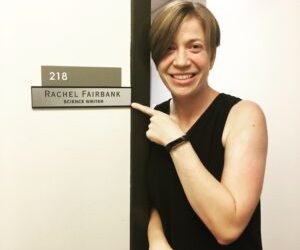
San Diego-based inewsource investigative reporter Jennifer Bowman has tracked policymakers’ responses to the region’s rising count of people with mental illness experiencing homelessness and the often futile efforts of family members to secure court orders involuntarily committing them to a medical treatment facility.
Bowman’s interest in those so-called conservatorships — which exist nationwide and vary widely, jurisdiction-by-jurisdiction — prompted her monthslong probe of the issue.
Funded partly by a USC Annenberg Center for Health Journalism fellowship grant, she led her nonprofit newsroom’s coverage of this topic, delivering a guide to the conservatorship process and articles on the hard decision to seek to have an ill relative involuntarily committed; California’s fractured and struggling conservatorship system; how her local county’s use of conservatorship violates state law; and her own family’s largely losing battle on behalf of her brother experiencing homelessness, who refuses treatment for his schizophrenia.
This inewsource series is important, given the challenges confronting those with hard-to-treat mental illnesses and their families. The topic merits coverage in communities everywhere.
What follows is an abridged version of my interview with Bowman about this work.
This story has been lightly edited for clarity and brevity.
How did this story land on your radar?
What we were seeing is what a lot of journalists were seeing.
On a statewide level, momentum was building to address rising homelessness of people with mental illness, and people were seeing conservatorships as a possible solution. The mayor of San Diego and the San Diego County Board of Supervisors were big proponents. So, we sought to localize that issue.
Also, I have a personal experience. My brother, who has schizophrenia, has been homeless for years in San Diego.
How did you pitch the idea to your editors and how did they respond to that pitch?
We do a lot of, just, general brainstorming at inewsource. And this idea had been coming. The mayor had made it a chief message in the state of the city speech, which was a point of discussion in our virtual newsroom.
I’d come up with some general ideas, asking, “How well is the system working locally?”
We talked about that before we applied for a fellowship to help fund the reporting.
Before we actually began the reporting, we did an off-the-record focus group, talking to folks with lived experience and professional experience in mental health.
And early on, I, as the reporter, plus the executive editor and the engagement editor, developed a content strategy. The data folks and interns eventually chimed in.
That engagement thing goes over my old schooler’s head. Peel that back.
I’m 33, and the engagement editor’s job goes over my head, too.
What we wanted to not do is just simply focus on how we can present this on Twitter. We got a lot of help from USC on this. We wanted community engagement. We wanted this coverage to be for the community we were reporting about, not just a general audience of news consumers. We did flyers and really focused on the language of those flyers, keeping it simple and clear.
We posted flyers in public libraries, coffee shops, on light poles near service providers. We also posted flyers in Spanish. I did a lot of intentional outreach, including asking service providers and other people not even connected to San Diego, “Who should I talk to, who should I reach out to, who do you know?”
For that hour-long focus group, I had a whole list of questions and I only needed to ask one of them; people really opened up. We realized that there are people who know much, much more than I, people who can really shape our reporting.
Through that focus group discussion, we decided to reach out to the family members of homeless people. We also tried to reach people who had gone through conservatorships, which was the really hard part, the part of our plan that didn’t quite work out. So, we were talking to people who were past their crisis but not getting to the people who were in the midst of psychosis or crisis.
How did you find people to interview for this series?
We went to homeless encampments and spoke to people — which itself is a challenge. How do we do that respectfully, without turning this into poverty porn?
I did talk to people who were not currently under a court order but who previously, over and over, had been in involuntary treatment. They didn’t make it into my on-the-record reporting but they informed my reporting.
Also, I did talk to one person who completed conservatorship and is now studying to be a lawyer. I think she might have been diagnosed with bipolar disorder. She ultimately believes the conservatorship helped her. She helped me understand the nuance [and] the rights of people being held involuntarily [and] their rights to lawyers.
Families, parents and loved ones trying to get help for their relatives reach out to her because she knows the quirks of the system.
Given the months you spent your reporting, how did you manage to not become dissuaded that this story would work out?
I definitely had doubts: “Is this even a story?” For one, I struggled with aiming to truly, fully highlight people with firsthand experience but ended up, instead, replacing them with family members.
When I was concerned about that, an editor from Annenberg told me, “If you can’t get to that person in crisis, who else is better to talk about that than their mom who has been struggling with them for years?” It was a very helpful insight.
Ultimately, we did the best we could.
What was the hardest part of this reporting for you, personally?
My family is still dealing with my brother, who is homeless in San Diego and doesn’t accept his schizophrenia diagnosis. He believes his family is brain-hacking him.
That knowledge helped with my reporting. Embracing that personal discouragement made me doubt and question myself in a way that helped me see the holes. It’s the kind of thing that can show you the places where you need to do more reporting.
Eventually, I did take some time away from the work to look at my body and myself and my wellness.
This notion of self-care, is that something you came to on your own? Or was it discussed when you were in J-school?
Journalists are told that this is a calling and that any time you suffer, that’s all part of the job. I’ve learned that is not healthy and not true. I’m passionate about my work but I’m also a mom and a wife. If I don’t take care of myself, I’m not a full human being.
My editors were very aware of my personal experience with this. Because of that, I was encouraged to take the time when I needed it.
What would you advise journalists who are tackling this topic?
There’s a quote that sums it up well: “People who shouldn’t be in that system end up there and people who should aren’t; they’re falling through the cracks.”
So, it’s no small thing to place a person under conservatorship. Conservatorships exist everywhere and are operated differently, not just state-by-state, but within states; and, here in California, county-by-county. That’s important to know.
Look for those details and that data, but embrace this engagement effort that we made. It was time-consuming and difficult to have these conversations. But it was such a worthy effort. There are things that I would not have known otherwise.
This is an important story. We’re talking about a process that takes away important decisions from these people’s lives. And there are people who are so sick they didn’t know they were in trouble.









